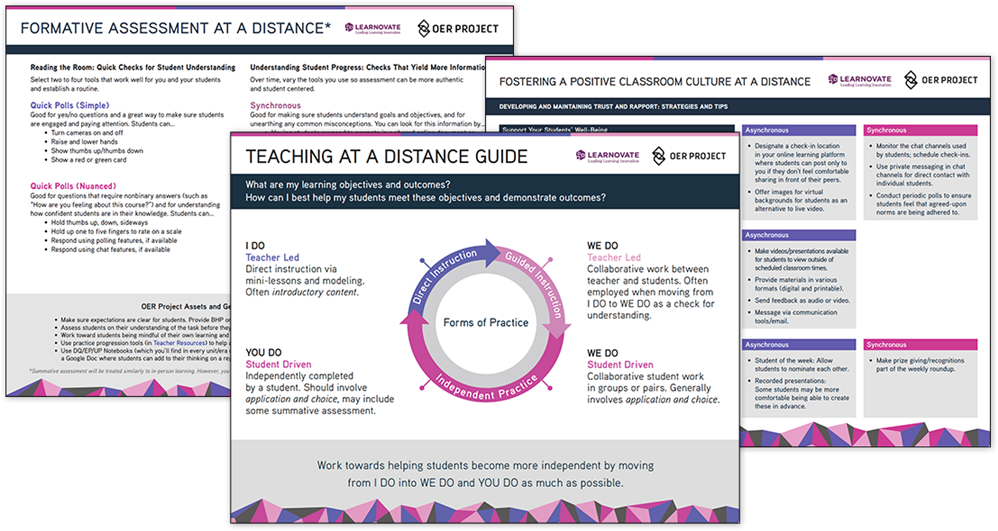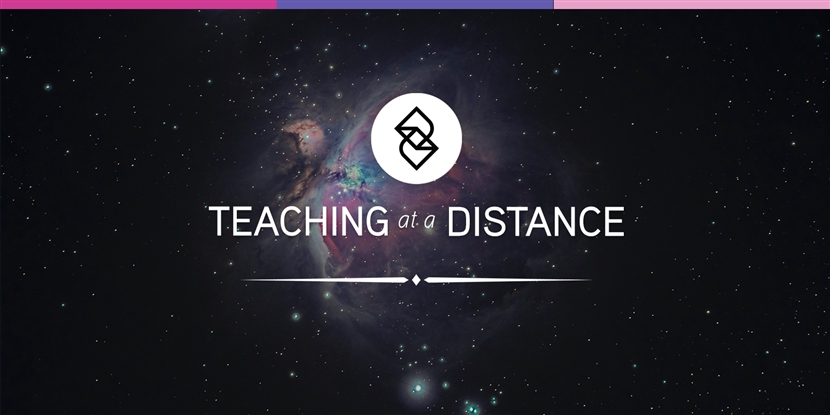This blog provides an explanation of what you'll find in our TaaD Center. Don't forget to log in with your OER Project account to access the TaaD Center itself!
As many of us transition into the wild west of teaching in 2020, we’re confronted with what feels like a million different models of teaching: teaching in school; teaching from home; teaching from school while some students are there and some are at home; teaching from school while everyone is at home—well, we’re all getting a bit dizzy. And while we know there’s no magic formula that’s going to make teaching and learning seamless under these circumstances, we at the OER Project have decided to put together a Teaching at a Distance (TaaD) Center. Our goal? Provide some support and guidance to help you navigate the school year.
The TaaD Center is divided into four sections: Overall Guides; Course Plans; Content Skills and Activities; and When All Else Fails. We will also put up a TaaD-related blog post each month and host conversations in the community about different TaaD topics. There are already a ton of conversations going on about TaaD, so go to the community and search for terms like “teaching at a distance,” “distance learning,” “teaching online,” and so on. Also, don’t forget to tag related posts with #TaaD. This will help others in their search for TaaD topics.
As you kick off the school year, let us know what else we can do to support you, and please share your tips and tricks and classroom wins with the community—we need each other more than ever. Stay safe and well!!
Overall Guides
We worked with Trinity College in Dublin to help us construct three frameworks related to teaching at a distance. Check out the linked guides for more detail.

Teaching at a Distance Framework – I Do, You Do, We Do
Our philosophies around teaching and learning haven’t changed because we’re not in the classroom. However, due to the shift in learning environments, our practices have to change. This can feel daunting. One trick for making this change is to use the I Do, You Do, We Do framework. The framework is simple—"I do” are the things you will have to teach or introduce. “We do” are the things you might do alongside students, or that they do alongside one another. “You do” are things students work on independently.
Assessment at a Distance
Assessment should be happening everywhere and all the time. Early in the school year, we recommend you focus on quick, formative assessments to help you “read the room.” Once you’ve established some initial routines and classroom practices, you can start digging into student learning a bit more, using rubrics, progression tools, and other course resources to assess student progress. Summative assessment may not look a whole lot different at a distance. Check out the guide for more detailed information on how to assess at a distance…and how to make your students more responsible for assessing their own learning.
Classroom Culture at a Distance
It’s more important than ever to foster a positive classroom culture. We are all facing new challenges and a huge amount of uncertainty in our lives. Before we can even get to teaching and learning, we must check in on our students’ well-being and make sure we’ve established a safe, comfortable a reading and watching videos, and new historical information. After you’ve completed introductory content, you can move into application and student choice. This will help you assess student understanding and will also give students options for some self-directed learning.
Content, Skills, and Activities
In this section of the Center, we will be sharing suggestions from teachers on converting specific OER Project activities for TaaD. We will also provide suggestions for how to teach skills progressions and other activities at a distance. Finally, look for short videos that will provide tips for both general TaaD strategies, as well as for specific OER Project assets.

When All Else Fails
When schools first started shutting down in the early spring of 2020, we put together two sets of resources to help teachers. First, Ian Usher, a distance teaching guru, wrote a series of blog posts with guiding principles for TaaD. We highly recommend checking this out if you are new to TaaD, or if you’re looking for resources to share with parents (here's a link to Ian's Week 1 Blog!). Second, BHP teacher Rachel Hansen and WHP Origins teacher Wood Boyles took us on a nine-week journey through each of the courses on Khan Academy. They posted a short daily video that consisted of a driving question, introduction to new content, a short assignment, and a prompt asking students to write a “historian’s journal” entry. These videos are an awesome resource that can be used in combination with your own teaching, and are another great place to point caretakers who suddenly find themselves homeschooling.

To access all these free materials and resources, head over to the TaaD Center. Not registered yet for the OER Project? Click here and sign up. It's fast, easy, and free!
 For full access to all OER Project resources AND our amazing teacher community,
For full access to all OER Project resources AND our amazing teacher community, 
Top Comments